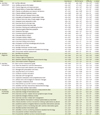1. Jang SN. Chronic illnesses and limited daily activities in the Korean elderly. Health Welf Policy Forum. 2015; 225:6–17.
2. Ministry of Health and Welfare, Korea Centers for Disease Control and Prevention. Korea Health Statistics 2015: Korea National Health and Nutrition Examination Survey (KNHANES VI-3). Sejong: Korea Centers for Disease Control and Prevention;2016.
3. Moon SJ, Shon CY, Kim JH, Kim HS, Lim HS, Lee HC, Huh KB. Measurement of nutrition counseling effects for diabetes mellitus patients. Korean J Nutr. 1994; 27:1070–1077.
4. White JV, Young E, Lasswell A. Position of the American Dietetic Association: nutrition-an essential component of medical education. J Am Diet Assoc. 1994; 94:555–557.

5. Um MH, Park YK, Lee SM, Lee SM, Lee E, Cha JA, Park MS, Lee HS, Rha MY, Lyu ES. Clinical nutrition service in Korean tertiary hospitals and general hospitals: result of nationwide cross-sectional survey. J Korean Diet Assoc. 2014; 20:183–198.

6. Park EC, Kim HA, Lee HY, Lee YE, Yang IS. A review of the medical nutrition therapy (MNT) of the U.S. medicare system. Korean J Community Nutr. 2002; 7:852–862.
7. Um MH, Park YK, Lee SM, Cha JA, Lee E, Lyu ES. Time measurement study of certified clinical dietitians from tertiary hospital in Seoul and Gyeonggi-do. J Korean Diet Assoc. 2015; 21:123–139.

8. Funnell MM, Brown TL, Childs BP, Haas LB, Hosey GM, Jensen B, Maryniuk M, Peyrot M, Piette JD, Reader D, Siminerio LM, Weinger K, Weiss MA. National standards for diabetes self-management education. Diabetes Care. 2012; 35:Suppl 1. S101–S108.

9. Thompson KL, Davidson P, Swan WI, Hand RK, Rising C, Dunn AV, Lewis N, Murphy WJ. Nutrition care process chains: the “missing link” between research and evidence-based practice. J Acad Nutr Diet. 2015; 115:1491–1498.

10. Porter JM, Devine A, Vivanti A, Ferguson M, O'sullivan TA. Development of a nutrition care process implementation package for hospital dietetic departments. Nutr Diet. 2015; 72:205–212.

11. Cha JA, Kim KE, Kim EM, Park MS, Park YK, Baek HJ, Lee SM, Choi SK, Seo JS. Development of job description of clinical dietitians in hospitals by the DACUM method. J Korean Diet Assoc. 2013; 19:265–286.

12. Seo JS, Kim EM, Park MS, Son JM, Woo MH, Wie KA, Lee SM, Ju DL, Cha JA. Job standards and practice toolkits for clinical nutrition therapy: diabetes mellitus·cancer·dyslipidemia. Cheongju: Ministry of Health and Welfare;2014.
13. Choi KB, Lee SM, Lyu ES. Patient perceptions of clinical nutrition service. J Korean Diet Assoc. 2012; 18:59–71.

14. Green CG. Using customer survey data to develop marketing strategies in college/university foodservices. J Coll Univ Foodserv. 1992; 1:39–51.

15. Lee JE, Kwak TK. Development and verification of indicators for a foodservice & nutrition management evaluation at a hospital nutrition department. J Korean Diet Assoc. 2009; 15:364–382.
16. Kim BG. Q·I in hospital nutrition service. Nutr Diet. 1997; 97:2–8.
17. Lee JH. Analyzing job satisfaction of hospital dietitians: based on job related factors of contracted foodservice management company [master's thesis]. Seoul: Yonsei University;2003.
18. Lee MJ, Lee YK. Effects of job characteristics, job performance and organizational commitment on job satisfaction of hospital dietitians in the Daegu Kyungpook area. Korean J Community Nutr. 2000; 5:672–682.
19. Choi J, Park E. Different perceptions of clinical nutrition services between doctors and dietitians in the Busan-Gyeongnam area. J Korean Diet Assoc. 2013; 19:69–81.

20. Ottery FD. Definition of standardized nutritional assessment and interventional pathways in oncology. Nutrition. 1996; 12:S15–S19.

21. Moon HK, Jang YJ. Analysis of the dietitian’s job description in the school. J Korean Diet Assoc. 2000; 8:143–153.
22. Kim SJ, Lim HJ, Cho YM, Lee HO, Choue RW. Present status of dietetic internship program in Korea. J Korean Diet Assoc. 2002; 8:408–414.
23. Kang JH, Jeong EH, Lee JS. Comparison study on perception of job importance, job performance, and job difficulty in clinical dietitians at small and medium hospitals in Busan. J Korean Diet Assoc. 2016; 22:26–40.












 PDF
PDF ePub
ePub Citation
Citation Print
Print



 XML Download
XML Download